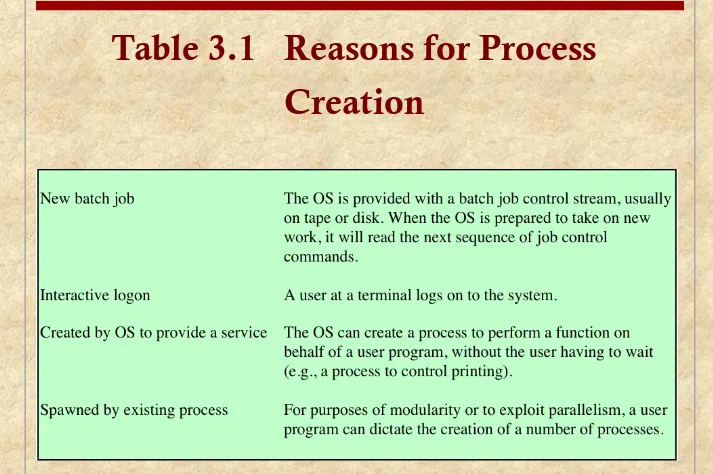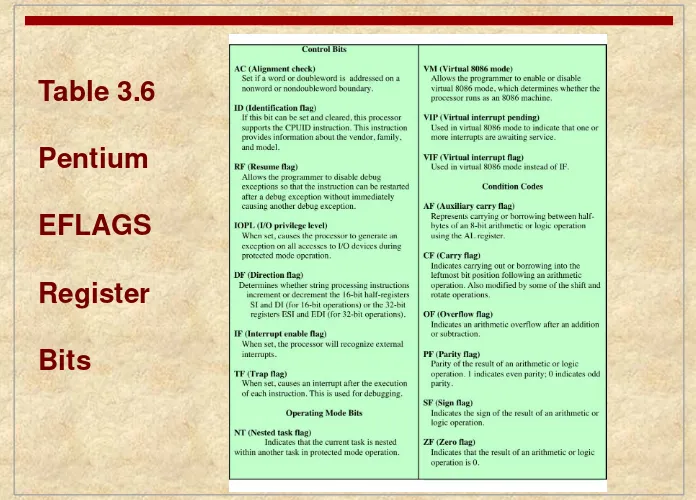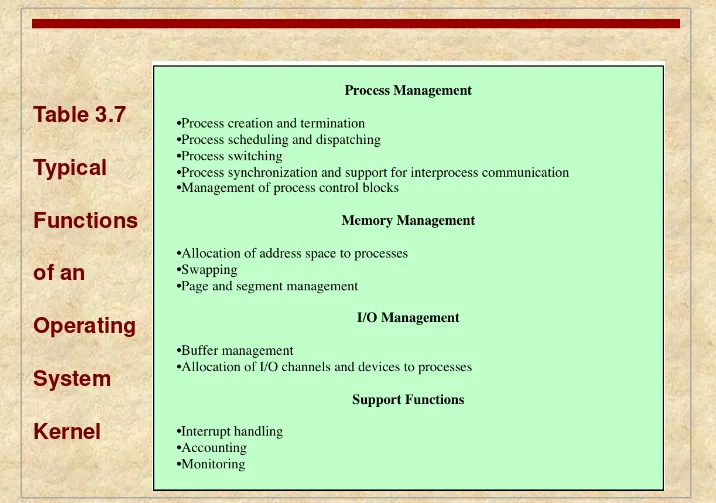Chapter 3
Process Description
and Control
Seventh Edition By William Stallings
Operating
Systems:
Internals
and Design
Operating Systems:
Internals and Design Principles
The concept of process is fundamental to the structure of
modern computer operating systems. Its evolution in
analyzing problems of synchronization, deadlock, and
scheduling in operating systems has been a major
intellectual contribution of computer science.
WHAT CAN BE AUTOMATED?: THE COMPUTER SCIENCE AND ENGINEERING RESEARCH STUDY,
A computer platform
consists of a collection
of hardware resources
Computer applications
are developed to
perform some task
It is inefficient for
applications to be
written directly for a
given hardware platform
The OS was developed to
provide a convenient,
feature-rich, secure, and
consistent interface for
applications to use
We can think of the OS as
providing a uniform,
abstract representation of
resources that can be
OS Management of
Application Execution
Resources are made available to multiple
applications
The processor is switched among multiple
applications so all will appear to be
progressing
The processor and I/O devices can be
Process Elements
Two essential elements of a process are:
When the processor begins to execute the program code, we refer to
this executing entity as a
process
Program code
which may be shared with other processes that are executing
the same program
While the program is executing, this process can be uniquely characterized by a number of elements, including:
identifier
state
priority
program
counter
memory
pointers
context data
I/O status
information
Process Control
Block
Contains the process elements
It is possible to interrupt a
running process and later resume execution as if the interruption had not occurred
Created and managed by the operating system
Process States
Trace
the behavior of an individual process
by listing the sequence of instructions that
execute for that process
the behavior of the processor can be characterized by showing how the traces of
the various processes are interleaved
Dispatcher
small program that switches the
processor from one process to
Process
Traces of
Processes
[image:10.720.168.710.19.503.2]of
Figure 3.2
Each process runs to completion
Combined
Trace of
Processes
[image:11.720.6.714.8.520.2]of
Figure 3.2
Two-State Process Model
A process may be in one of two states:
running
Table 3.1 Reasons for Process
Process Creation
Process
spawning
•
when the
OS creates a
process at
the explicit
request of
another
process
Parent process
•
is the
original,
creating,
process
Child process
•
is the new
Process Termination
There must be a means for a process to indicate its
completion
A batch job should include a HALT instruction or an
explicit OS service call for termination
For an interactive application, the action of the user will
indicate when the process is completed (e.g. log off,
Table 3.2
Swapping
involves moving part of all of a process from main memory to disk
The process may or may
not be waiting on an
event
The process may not be
removed from this state
until the agent explicitly
orders the removal
The process is not
immediately available
for execution
Reasons for Process Suspension
OS
Used to keep track of both
main (real) and secondary
(virtual) memory
Processes are maintained
on secondary memory
using some sort of virtual
memory or simple
swapping mechanism
Must include:
allocation of main memory to processes
allocation of secondary memory to processes
protection attributes of blocks of main or virtual memory information needed to manage
Used by the OS to manage
the I/O devices and
channels of the computer
system
At any given time, an I/O
device may be available or
assigned to a particular
process
If an I/O operation is in
progress, the OS needs to
know:
the status of the I/O operation
the location in main memory being used as the
Information may be maintained and used by a file management system
in which case the OS has little or no knowledge of files
In other operating systems, much of the detail of file management is managed by the OS itself
•
existence of files
•
location on secondary
memory
•
current status
•
other attributes
Must be maintained to manage processes
There must be some reference to memory,
I/O, and files, directly or indirectly
The tables themselves must be accessible by
•
where the
process is
located
•
the attributes of
the process that
are necessary for
its management
To manage
and
control a
process the
Process Location
A process must include a
program or set of programs to be executed
A process will consist of at least sufficient memory to hold the programs and data of that process
The execution of a program typically involves a stack that is used to keep track of procedure calls and parameter passing between procedures
Process Attributes
Each process has associated with it a number of attributes that are used by the OS for process
control
The collection of program, data, stack, and attributes is referred to as the process image
Process image location will depend on the memory
Each process is assigned a unique numeric identifier
otherwise there must be a mapping that allows the OS to locate the appropriate tables based on the process identifier
Many of the tables controlled by the OS may use process
identifiers to cross-reference process tables
Memory tables may be
organized to provide a map of main memory with an indication of which process is assigned to each region
similar references will appear in I/O and file tables
When processes communicate with one another, the process identifier informs the OS of the destination of a particular
communication
When processes are allowed to create other processes,
identifiers indicate the parent and descendents of each
Program status word
(PSW)
•
contains condition codes
plus other status
information
•
EFLAGS register is an
example of a PSW used by
any OS running on an x86
processor
Consists of the
contents of
processor registers
•
user-visible registers
•
control and status
registers
Table 3.6
Pentium
EFLAGS
Register
The additional information needed by the OS to
control and coordinate the various active
Typical
Elements
of a Process
The most important data structure in an OS
contains all of the information about a process that is needed by the OS
blocks are read and/or modified by virtually every module in the OS
defines the state of the OS
Difficulty is not access, but protection
a bug in a single routine could damage process control blocks, which
could destroy the system’s ability to manage the affected processes
User Mode
less-privileged mode
user programs
typically execute in
this mode
System Mode
more-privileged mode
also referred to as
control mode or
kernel mode
kernel of the
Table 3.7
Typical
Functions
of an
Once the OS decides to create a new process it:
assigns a unique process identifier to the new process
allocates space for the process
initializes the process control block
sets the appropriate linkages
Process Switching
System Interrupts
Interrupt
Due to some sort of event that is external to and
independent of the currently running process
clock interrupt
I/O interrupt
memory fault
Time slice
the maximum amount of time that a process can execute before being interrupted
Trap
An error or exception
condition generated within the currently running process
OS determines if the condition is fatal
moved to the Exit state and a process switch occurs
If no interrupts are
pending the processor:
proceeds to the fetch stage and fetches the next instruction of the current
program in the current process
If an interrupt is
pending the processor:
sets the program counter to the starting address of an interrupt handler program
switches from user mode to kernel mode so that the interrupt processing code may
The steps in a full process switch are:
save the context of the processor
update the process control block of
the process currently in the
Running state
move the process control block of this process to the appropriate queue
select another process for
execution
update the process control block of
the process selected update memory
management data structures restore the context
of the processor to that which existed
at the time the selected process was
last switched out
Execution
of the
Execution
Within
An OS associates a set of privileges with each process
Typically a process that executes on behalf of a user has the privileges that the OS recognizes for that user
Highest level of privilege is referred to as adminstrator, supervisor, or root access
A key security issue in the design of any OS is
to prevent, or at least detect, attempts by a user or a malware from gaining unauthorized privileges
Intruders
Often referred to as a hacker or cracker
Objective is to gain access to a system or to increase the range of privileges accessible on a system
Attempts to acquire information that should have been protected
Malicious Software
Most sophisticated types of threats to computer systems
Can be relatively harmless or very damaging
Classes:
• Masquerader
• Misfeasor
• Clandestine user
Categories:
•those that need a host program (parasitic)
• viruses, logic bombs, backdoors
•those that are independent
“A security service that monitors and analyzes system events for the
purpose of finding, and providing real-time or near real-time warning
of, attempts to access system resources in an unauthorized manner”
(RFC 2828)
May be host or network based
An intrusion detection system (IDS) comprises three logical components:
IDSs are typically designed to detect human intruder behavior as well as malicious software behavior
“The process of verifying
an identity claimed by or
for a system entity.”
(RFC2828)
An authentication process consists of two steps:
Identification
Verification
Four general means of
authenticating a user’s
identity: something the individual knows something the individual possesses something the individual is
(static biometrics)
something the individual does
Implements a security policy that specifies who or what may have access to each specific system resource and the type of access that is permitted in each instance
Mediates between a user and system resources
A security administrator maintains an authorization database
• interfaces with computers outside a network
• has special security
precautions built into it to protect sensitive files on
computers within the network
A dedicated
computer
that:
• all traffic must pass through the firewall
• only authorized traffic will be allowed to pass
• immune to penetration
Design
goals of a
Unix SVR4
Uses the model where most of the OS executes within the environment of a user process
System processes run in kernel mode
executes operating system code to perform administrative and housekeeping functions
User Processes
operate in user mode to execute user programs and utilities
operate in kernel mode to execute instructions that belong to the kernel
Table 3.11
UNIX
Process
Table 3.12
UNIX U
Process
creation is by means of the kernel system call, fork( )
This causes the OS, in Kernel Mode, to:
1 • Allocate a slot in the process table for the new process 2 • Assign a unique process ID to the child process
3
• Make a copy of the process image of the parent, with the exception of any shared memory
4
• Increments counters for any files owned by the parent, to reflect that an additional process now also owns those files
5 • Assigns the child process to the Ready to Run state 6
After creating the process the Kernel can do one of the
following, as part of the dispatcher routine:
stay in the parent process
transfer control to the child process
Summary
The most fundamental concept in a modern OS is the process
The principal function of the OS is to create, manage, and terminate processes
Process control block contains all of the information that is required for the OS to manage the process, including its current state, resources
allocated to it, priority, and other relevant data
The most important states are Ready, Running and Blocked
The running process is the one that is currently being executed by the processor
A blocked process is waiting for the completion of some event




